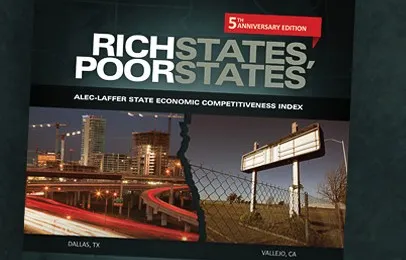Right to Work a ‘Policy For Growth’


In the middle of this week, the American Legislative Exchange Council (ALEC) released the fifth edition of its “Rich States, Poor States†report. (See the link above for information about how to obtain a copy. A free electronic version is available.) The authors of “Rich States, Poor States†are Arthur Laffer, chairman of Laffer Associates and one of the most influential economists of our time, Stephen Moore, the senior economics writer for the Wall Street Journal as well as a member of its editorial board, and Jonathan Williams, director of ALEC’s Center for State Fiscal Reform along with its Tax and Fiscal Policy Task Force.
As have previous editions, the fifth edition of “Rich States, Poor States†highlights important data showing that states with Right to Work laws on the books that protect employees from being fired for refusal to pay dues or fees to an unwanted union “grow faster than states with forced unionism.†The report identifies such laws as one of five key “policies for growth.†And Right to Work is the only non-tax policy on the list.
One telling statistic cited by Laffer, Moore and Williams comes from a 2010 scholarly article by economist Richard Vedder of Ohio University. Vedder’s article noted that, from 2000 to 2008, a net total of 4.8 million Americans moved from forced-unionism states to Right to Work states. That amounts to “one person every minute of every day.†And Laffer, Moore and Williams deftly refute the claim advanced by a number of apologists for compulsory unionism that weather is a leading factor driving the out-migration from states with compulsory unionism and heavy tax burdens:
If that were true, wouldn’t people be moving to [forced-unionism] California and Hawaii in droves? Census data show this simply isn’t happening. Over the last 20 years, 3.6 million more Americans have moved out of California than moved in, and 130,000 more Americans have moved from Hawaii than to it. Moreover, in 2010, the beautiful state of California did not gain a congressional seat for the first time since 1850. In striking contrast, [Right to Work] Texas gained four congressional seats. Additionally, as the Census data show, [Right to Work] Florida gained 2.3 million net residents since 1980.
Good point. Perhaps an even more powerful indicator that the ongoing, massive net out-migration from forced-unionism states is primarily driven by economics, not lifestyle considerations, is the fact that there is a greater net movement into Right to Work states of young adults and their children than of retirees. From 2000 to 2010, Census data show, Right to Work states’ total population aged 25-34 grew by 9.2%, even as forced-unionism states’ contingent of young adults in that age bracket fell by 1.0%! Not one of the 16 states that suffered a net decline in young-adult population has a Right to Work law on the books. But eight of the 10 states with the greatest percentage gains in young-adult population are Right to Work states. And immigration from abroad offers no explanation for the disparity. In fact, although forced-unionism California took in huge numbers of young-adult immigrants from 2000 to 2010, the Golden State’s overall young-adult population increased by just 1.7%, less than a fifth of the Right to Work state average and far less than in relatively low-immigration Right to Work states like Kansas, Nebraska and Wyoming.

